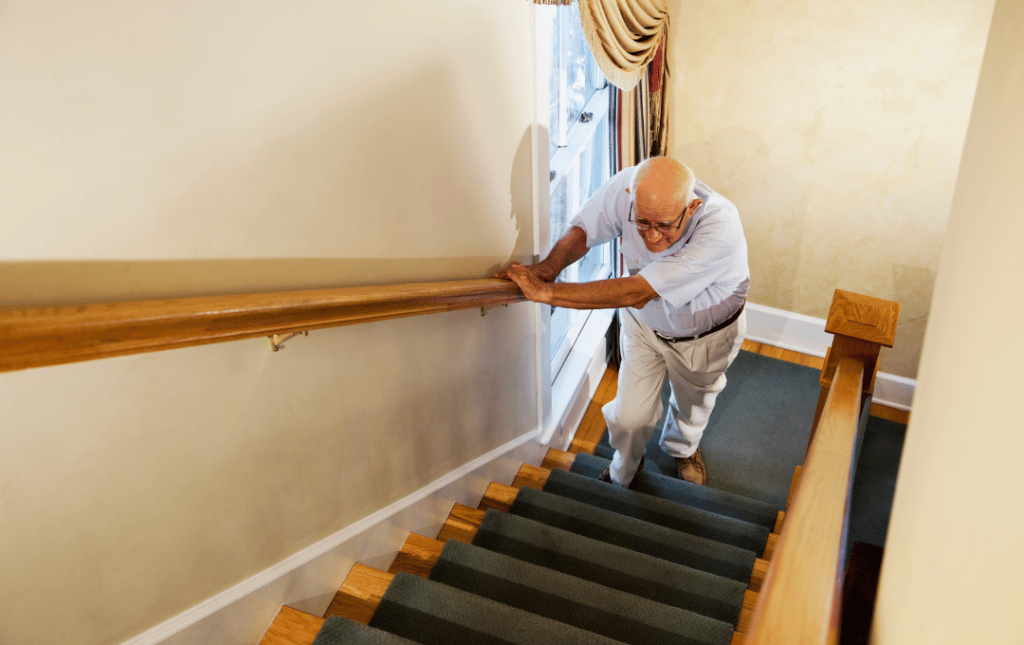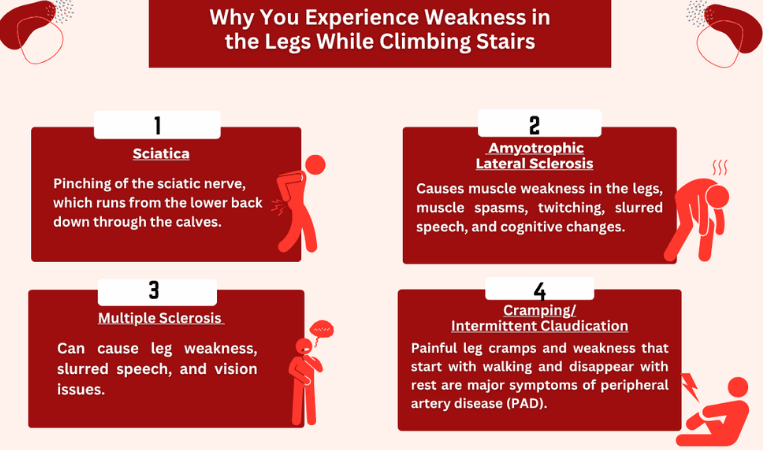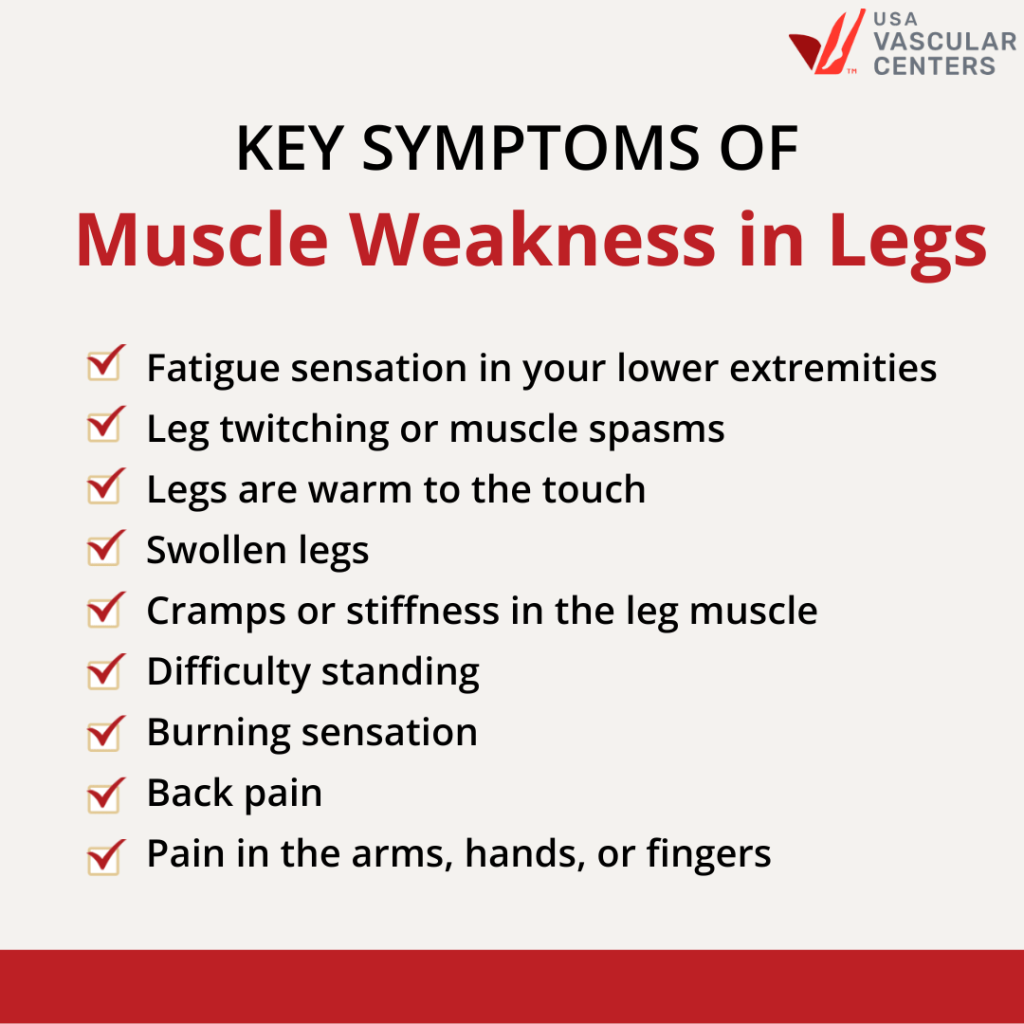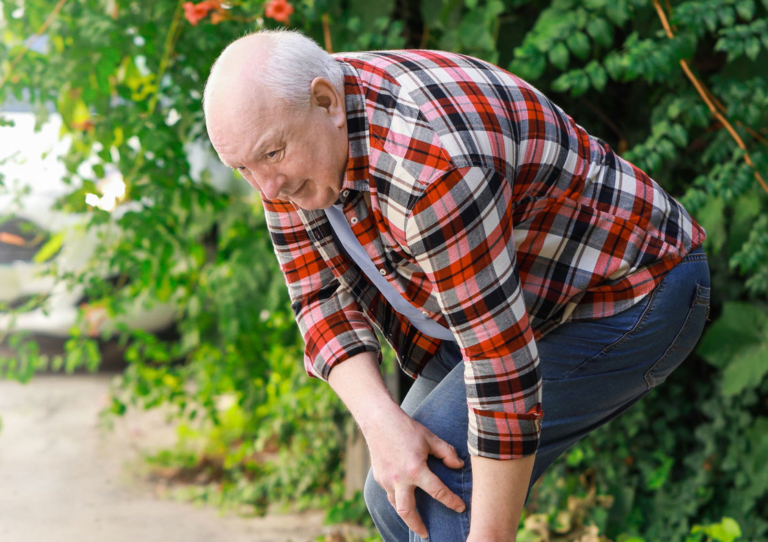Are your legs shaky or weak when climbing stairs? Are you feeling excessively fatigued after a short walk upstairs or struggling to maintain stability when walking downstairs?
Occasional pain in the legs is typically a sign of joint problems or nerve issues. However, if the pain gets progressively worse with movement or improves at rest, it might be a sign of a more serious vascular disease, like peripheral artery disease (PAD).
This blog will explore the common causes of leg weakness when climbing stairs, so you know when it could be a sign of a more serious circulatory issue.
Recognizing What Leg Weakness Feels Like When Climbing Stairs
Leg weakness feels different for everyone. Some individuals experience heaviness in their thighs and calves when exercising. When this occurs while climbing stairs, some individuals may need to use a handrail for extra support to maintain stability. This type of pain is typically sudden and intense.
Other individuals experience persistent, gradual leg pain or a total loss of control when climbing stairs. Persistent pain in the legs when climbing the stairs is considered abnormal and could be a sign of a vascular disease. These symptoms are often mistaken for aging or overexertion, which is why vascular diseases like peripheral artery disease (PAD) often go undiagnosed.
Take our online PAD risk assessment quiz to help determine if you are at risk and should schedule a proper diagnosis with a specialist.
Common Causes of Leg Weakness
Leg weakness can be driven by a variety of serious and non-serious causes. Seven common causes include:
- Poor Circulation – Certain vascular conditions can disrupt blood flow, leading to leg pain and weakness.
- Muscle deconditioning – Reduced muscle strength, often caused by aging or a decrease in physical activity, can lead to pain and fatigue in the lower extremities.
- Joint degeneration or arthritis – Can cause stiffness in the knees, making it more challenging to walk up and down stairs.
- Nerve compression or neuropathy – Causes numbness or a tingling sensation in the legs and feet, which can make walking or climbing stairs painful.
- Previous injuries or surgeries – Trauma to the legs and feet can impair muscle strength, leading to pain and weakness.
- Poor balance or coordination – Instability caused by muscle weakness or inner ear issues can make climbing stairs more challenging.
- Fatigue from exertion – Overexertion, anemia, or respiratory issues can cause extreme leg fatigue after climbing stairs.
Why Leg Weakness May Feel Different When Going Up or Down Stairs
When leg weakness occurs, different levels of discomfort may be noticed when going up versus down stairs. Going downstairs works different muscle groups in the legs. It puts more strain on the calves and knees, which can be painful if you have joint instability issues.
Climbing upstairs requires more energy and works more muscle groups in the legs. If you experience leg weakness when climbing upstairs, it could be a sign of muscle weakness or a serious vascular condition, making it important to monitor symptoms to address the correct underlying cause.
When walking up and down stairs, tracking patterns of pain and symptoms can help narrow potential causes and determine if and when it’s time to seek medical treatment.
Why Poor Circulation May Make Climbing Stairs Harder
When blood flow is restricted, the muscles in the lower extremities do not receive enough oxygen to support the movement occurring. This can lead to unwanted pain, fatigue, and heaviness in the legs when walking, climbing stairs, or partaking in physical activities.
If your leg pain or weakness is caused by a circulatory issue, the pain worsens during movement and improves when resting. This is because your legs don’t require as much oxygen when your body is at rest, which can lead to cramping called claudication.
Circulatory Conditions That Can Affect Stair Climbing
Several different vascular conditions can cause circulatory issues in the lower extremities, making it more challenging to climb stairs.
Some common causes of circulatory issues include:
- Peripheral artery disease (PAD): A serious vascular condition that causes the arteries to narrow, reducing the flow of blood, oxygen, and nutrients to the lower extremities.
- Chronic venous insufficiency (CVI): Damaged vein valves lead to the blood pooling in the legs, causing leg heaviness and weakness.
- Deep vein thrombosis (DVT): DVT causes blood clots to form in deep veins in the legs, leading to leg pain, swelling, and discomfort.
- Lymphedema: Lymph fluid buildup causes the extremities to swell, leading to pain, tingling, and heaviness.
Peripheral Artery Disease and Difficulty Climbing Stairs
Peripheral artery disease (PAD) is caused by a buildup of plaque in the arteries. As the plaque builds up, it restricts the flow of blood, oxygen, and nutrients to the legs and feet. This condition can cause leg pain, cramping, and extreme fatigue when climbing stairs. PAD leg pain can occur in one or both legs. If the pain is persistent in one leg, it could mean there’s a blockage in the arteries on one side.
PAD is a progressive disease, and symptoms tend to get worse over time. Decreased circulation within the lower extremities can cause the legs to feel heavy or tired. The sensation of physical heaviness can make it close to impossible to lift your legs to climb stairs. PAD symptoms tend to reduce or stop completely when you are at rest. Many people who have symptomatic PAD refrain from exercising or moving around because this feeling of fatigue, heaviness, or pain deters them from being active.
Intermittent claudication is another term that is often associated with PAD. It describes chronic leg pain caused by decreased blood flow. Pain caused by claudication can range from dull, aching pain to severe cramp-like stabs in the buttocks, thighs, or calves. As with other conditions that cause leg weakness, intermittent claudication typically occurs during walking or exercise and resolves at rest.
PAD Leg Symptoms vs. Other Causes of Fatigue From Climbing Stairs
Patients with PAD typically experience leg weakness when climbing stairs as well as coldness, skin discoloration, and slow-healing wounds. Other indicators may include hair loss on the legs, shiny skin, or a tingling sensation in the legs or feet.
The leg pain and fatigue are persistent when moving and typically improve when at rest, while nerve and joint issues are sharp and occasional. Leg pain caused by nerve or joint issues may worsen with increased exertion.
If you’re experiencing leg fatigue when climbing stairs and are worried that symptoms may be related to PAD, use our online risk assessment quiz to see if you are at risk of PAD.
Difficulty Climbing Stairs Symptom Checker
Treatment for Leg Weakness Caused by Peripheral Artery Disease (PAD)
Peripheral artery disease is a serious vascular condition that requires medical intervention. If warning signs of PAD or known risk factors are present, scheduling a vascular screening with a specialist is strongly recommended.
A vascular specialist will use an ankle-brachial index (ABI) test or ultrasound to identify any blockages in the arteries that may be causing leg weakness when climbing the stairs. If PAD is diagnosed, non-surgical procedures may be used to restore blood flow. At USA Vascular Centers, three minimally invasive treatment options are available:
- Angioplasty: A balloon connected to a catheter is placed into the artery and used to compress the plaque against the artery wall.
- Stent placement: A stent keeps the affected artery propped open to prevent future blockages. This procedure can be used on its own or with an angioplasty.
- Atherectomy: A catheter equipped with a laser or blade is used to physically remove plaque from the affected artery.
Get Help for Leg Weakness & Pain When Climbing Stairs
Difficulty climbing stairs and leg weakness are not always a cause for concern. However, if pain is consistent or only occurs when exerting energy, it can be a sign of a more serious vascular condition.
Peripheral artery disease is a progressive condition that requires early medical intervention. USA Vascular Centers offer non-surgical treatments designed to help restore blood flow and improve mobility, with a personalized treatment plan tailored to each individual’s specific needs. We also accept most insurances, including Medicare and Medicaid.



